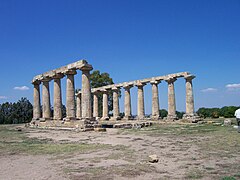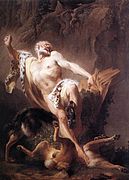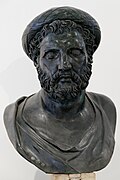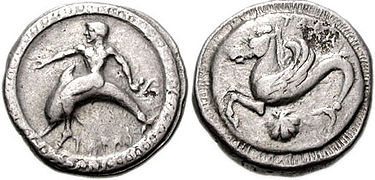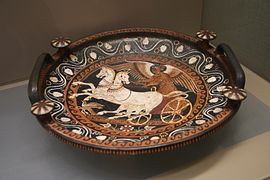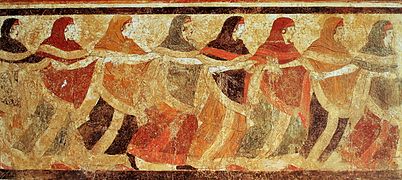Magna Graecia: Difference between revisions
Tags: Mobile edit Mobile web edit |
No edit summary |
||
| Line 23: | Line 23: | ||
}} |
}} |
||
'''Magna Graecia''' ({{IPAc-en|ˌ|m|æ|ɡ|n|ə|_|ˈ|ɡ|r|iː|s|i|ə|,_|ˈ|ɡ|r|iː|ʃ|ə}}, {{IPAc-en|US|ˌ|m|æ|ɡ|n|ə|_|ˈ|ɡ|r|eɪ|ʃ|ə}}; [[Latin]] meaning "Great Greece", {{lang-el|Μεγάλη |
'''Magna Graecia''' ({{IPAc-en|ˌ|m|æ|ɡ|n|ə|_|ˈ|ɡ|r|iː|s|i|ə|,_|ˈ|ɡ|r|iː|ʃ|ə}}, {{IPAc-en|US|ˌ|m|æ|ɡ|n|ə|_|ˈ|ɡ|r|eɪ|ʃ|ə}}; [[Latin]] meaning "Great Greece", {{lang-el|Μεγάλη Ελλάς}}, ''Megáli Ellás'', {{lang-it|Magna Grecia}}) was the name given by the Romans to the coastal areas of [[Southern Italy]] in the present-day regions of [[Campania]], [[Apulia]], [[Basilicata]], [[Calabria]] and [[Sicily]]; these regions were [[Colonies in antiquity#Greek colonies|extensively populated]] by [[Greeks|Greek]] settlers, particularly the [[Achaeans (tribe)|Achaean]] settlements of [[Crotone|Croton]], and [[Sybaris]], and to the north, the settlements of [[Cumae]] and [[Naples|Neapolis]].<ref>The Oxford Companion to Classical Literature, Paul Harvey, 1927,1955, p258</ref> The settlers who began arriving in the 8th century BC brought with them their [[Hellenic civilization]], which was to leave a lasting imprint on Italy, such as in the culture of [[ancient Rome]]. Most notably the Roman poet [[Ovid]] referred to the south of Italy as ''Magna Graecia'' in his poem ''[[Fasti (poem)|Fasti]]''. |
||
==Antiquity== |
==Antiquity== |
||
Revision as of 10:24, 23 November 2019
| History of Italy |
|---|
 |
|
|
| History of Greece |
|---|
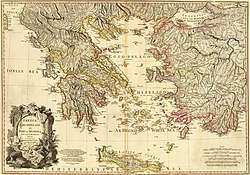 |
|
|
Magna Graecia
Μεγάλη Ελλάς | |
|---|---|
 | |
| Present status | |
Magna Graecia (/ˌmæɡnə ˈɡriːsiə, ˈɡriːʃə/, US: /ˌmæɡnə ˈɡreɪʃə/; Latin meaning "Great Greece", Greek: Μεγάλη Ελλάς, Megáli Ellás, Italian: Magna Grecia) was the name given by the Romans to the coastal areas of Southern Italy in the present-day regions of Campania, Apulia, Basilicata, Calabria and Sicily; these regions were extensively populated by Greek settlers, particularly the Achaean settlements of Croton, and Sybaris, and to the north, the settlements of Cumae and Neapolis.[1] The settlers who began arriving in the 8th century BC brought with them their Hellenic civilization, which was to leave a lasting imprint on Italy, such as in the culture of ancient Rome. Most notably the Roman poet Ovid referred to the south of Italy as Magna Graecia in his poem Fasti.
Antiquity
According to Strabo, Magna Graecia's colonization had already begun by the time of the Trojan War and lasted for several centuries.[2]
In the 8th and 7th centuries BC, because of demographic crises (famine, overcrowding, etc.), stasis (political crisis), the search for new commercial outlets and ports, and expulsion from their homeland after wars, Greeks began to settle in southern Italy.[3] Colonies were established all over the Mediterranean and Black Seas (with the exception of Northwestern Africa, in the sphere of influence of Carthage), including in Sicily and the southern part of the Italian Peninsula. The Romans called the area of Sicily and the foot of Italy Magna Graecia (Latin for "Great Greece") since it was so densely inhabited by the Greeks. The ancient geographers differed on whether the term included Sicily or merely Apulia and Calabria, Strabo being the most prominent advocate of the wider definitions.[citation needed]
With colonization, Greek culture was exported to Italy, in its dialects of the Ancient Greek language, its religious rites and its traditions of the independent polis. An original Hellenic civilization soon developed, later interacting with the native Italic civilisations. The most important cultural transplant was the Chalcidean/Cumaean variety of the Greek alphabet, which was adopted by the Etruscans; the Old Italic alphabet subsequently evolved into the Latin alphabet, which became the most widely used alphabet in the world. [citation needed]
These Hellenic colonies became very rich and powerful, and some still stand today, like Neapolis ("New City", now Naples), Syracuse, Akragas (Agrigento), Taras (Taranto), Rhegion (Reggio Calabria), or Kroton (Crotone).[citation needed]
The first Greek city to be absorbed into the Roman Republic was Neapolis in 327 BC.[4] The other Greek cities in Italy followed during the Samnite Wars and the Pyrrhic War; Taras was the last to fall in 272. Sicily was conquered by Rome during the First Punic War. Only Syracuse remained independent until 212, because its king Hiero II was a devoted ally of the Romans. His grandson Hieronymous however made an alliance with Hannibal, which prompted the Romans to besiege the city, which fell in 212, despite the machines of Archimedes.[citation needed]
-
5th century BC Greek coins of Tarentum
List of Hellenic Poleis in Italy
This is a list of the 22 poleis (city states) in Italy, according to Mogens Herman Hansen.[5] It does not list all the Hellenic settlements, only those organised around a polis structure.
| Ancient name(s) | Location | Modern name(s) | Foundation date | Mother city | Founder(s) |
| Herakleia (Lucania)[6] | Basilicata | abandoned | 433–432 BC | Taras (and Thourioi) | ? |
| Hipponion[7] | Calabria | Vibo Valentia | late 7th century BC | Lokroi Epizephiroi | ? |
| Hyele, or Elea, Velia (Roman name)[8] | Campania | abandoned | c.540–535 BC | Phokaia, Massalia | Refugees from Alalie |
| Kaulonia[9] | Calabria | abandoned | 7th century BC | Kroton | Typhon of Aigion |
| Kroton[10] | Calabria | Crotone | 709–708 BC | Rhypes, Achaia | Myscellus |
| Kyme, Cumae (Roman name)[11] | Campania | abandoned | c.750–725 BC | Chalkis and Eretria | Hippokles of Euboian Kyme and Megasthenes of Chalkis |
| Laos[12] | Calabria | abandoned | before 510 BC | Sybaris | Refugees from Sybaris |
| Lokroi (Epizephiroi)[13] | Calabria | Locri | early 7th century BC | Lokris | ? |
| Medma[14] | Calabria | abandoned | 7th century BC | Lokroi Epizephiroi | ? |
| Metapontion[15] | Basilicata | abandoned | c. 630 BC | Achaia | Leukippos of Achaia |
| Metauros[16] | Calabria | Gioia Tauro | 7th century BC | Zankle (or possibly Lokroi Epizephiroi) | ? |
| Neapolis[17] | Campania | Naples | c. 470 BC | Kyme | ? |
| Pithekoussai[18] | Campania | Ischia | 8th century BC | Chalkis and Eretria | ? |
| Poseidonia, Paestum (Roman name)[19] | Campania | abandoned | c. 600 BC | Sybaris (and perhaps Troizen) | ? |
| Pyxous[20] | Campania | Policastro Bussentino | 471–470 BC | Rhegion and Messena | Mikythos, tyrant of Rhegion and Messena |
| Rhegion[21] | Calabria | Reggio Calabria | 8th century BC | Chalkis (with Zankle and Messenian refugees) | Antimnestos of Zankle (or perhaps Artimedes of Chalkis) |
| Siris[22] | Basilicata | abandoned | c. 660 BC (or c. 700 BC) | Kolophon | Refugees from Kolophon |
| Sybaris[23] | Calabria | Sibari | 721–720 (or 709–708) BC | Achaia and Troizen | Is of Helike |
| Taras[24] | Apulia | Taranto | c. 706 BC | Sparta | Phalanthos and the Partheniai |
| Temesa[25] | unknown, but in Calabria | abandoned | no Greek founder (Ausones who became Hellenised) | ||
| Terina[26] | Calabria | abandoned | before 460 BC, perhaps c. 510 BC | Kroton | ? |
| Thourioi[27] | Calabria | abandoned | 446 and 444–443 BC | Athens and many other cities | Lampon and Xenokrates of Athens |
Middle Ages
| History of Greece |
|---|
 |
|
|
During the Early Middle Ages, following the disastrous Gothic War, new waves of Byzantine Christian Greeks may have come to Southern Italy from Greece and Asia Minor, as Southern Italy remained loosely governed by the Eastern Roman Empire. Although possible, the archaeological evidence shows no trace of new arrivals of Greek peoples, only a division between barbarian newcomers, and Greco-Roman locals. The iconoclast emperor Leo III appropriated lands that had been granted to the Papacy in southern Italy and the Eastern Roman (Byzantine) Empire continued to govern the area in the form of the Catapanate of Italy through the Middle Ages, well after northern Italy fell to the Lombards.[28]
At the time of the Normans' late medieval conquest of southern Italy and Sicily (in the late 12th century), the Salento peninsula (the "heel" of Italy) and up to one third of Sicily was still Greek speaking (concentrated in the Val Demone).[29] At this time the language had evolved into medieval Greek, also known as Byzantine Greek, and its speakers were known as Byzantine Greeks. The resultant fusion of local Byzantine Greek culture with Norman and Arab culture (from the Arab occupation of Sicily) gave rise to Norman-Arab-Byzantine culture on Sicily.
A remnant of this influence can be found in the survival of the Greek language in some villages of the above mentioned Salento peninsula (the "heel" of Italy). This living dialact of Greek, known locally as Griko, is found in the Italian regions of Calabria and Apulia. Griko is considered by linguistics to be a descendant of Byzantine Greek, which had been the majority language of Salento through the Middle Ages, combining also some ancient Doric and modern Italian elements. There is a rich oral tradition and Griko folklore, limited now but once numerous, to around 30,000 people, most of them having become absorbed into the surrounding Italian element. Some scholars, such as Gerhard Rohlfs, argue that the origins of Griko may ultimately be traced to the colonies of Magna Graecia.[citation needed]
Modern Italy
Although many of the Greek inhabitants of Southern Italy were entirely Latinized during the Middle Ages (for example, Paestum was by the 4th century BC), pockets of Greek culture and language remained and survived into modernity partly because of continuous migration between southern Italy and the Greek mainland. One example is the Griko people, some of whom still maintain their Greek language and customs.
Greeks re-entered the region in the 16th and 17th century in reaction to the conquest of the Peloponnese by the Ottoman Empire. Especially after the end of the Siege of Coron (1534), large numbers of Greeks took refuge in the areas of Calabria, Salento and Sicily. Greeks from Coroni, the so-called Coronians, were nobles, who brought with them substantial movable property. They were granted special privileges and tax exemptions.
Other Greeks who moved to Italy came from the Mani Peninsula of the Peloponnese. The Maniots were known for their proud military traditions and for their bloody vendettas, many of which still continue today. Another group of Maniot Greeks moved to Corsica. [citation needed]
See also
References
- ^ The Oxford Companion to Classical Literature, Paul Harvey, 1927,1955, p258
- ^ [ Strabo, Geographica οἱ δὲ τῆς Σικελίας τύραννοι καὶ μετὰ ταῦτα Καρχηδόνιοι, τοτὲ μὲν περὶ τῆς Σικελίας πολεμοῦντες πρὸς Ῥωμαίους τοτὲ δὲ περὶ αὐτῆς τῆς Ἰταλίας, ἅπαν- τας τοὺς ταύτῃ κακῶς διέθηκαν, μάλιστα δὲ τοὺς Ἕλληνας, πρότερον μέν γε καὶ τῆς μεσογαίας πολλὴν ἀφῄρηντο, ἀπὸ τῶν Τρωικῶν χρόνων ἀρξάμενοι, καὶ δὴ ἐπὶ τοσοῦτον ηὔξηντο ὥστε τὴν μεγάλην Ἑλλάδα ταύτην ἔλεγον καὶ τὴν Σικελίαν· νυνὶ δὲ πλὴν Τάραντος καὶ Ῥηγίου καὶ Νεαπόλεως ἐκβεβαρβαρῶσθαι συμβέβηκεν ἅπαντα καὶ τὰ μὲν Λευκανοὺς καὶ Βρεττίους κατέχειν τὰ δὲ Καμπανούς, καὶ τούτους λόγῳ, τὸ δ' ἀληθὲς Ῥωμαίους· καὶ γὰρ αὐτοὶ Ῥωμαῖοι γεγόνασιν. ]
- ^ Cerchiai et al., The Greek cities of Magna Graecia and Sicily, pp. 14–18.
- ^ Heitland, William Emerton (1911). A Short History of the Roman Republic. The University Press. p. 72.
- ^ Hansen and Nielsen, Inventory of Archaic and Classical Poleis, pp. 249–320.
- ^ Hansen and Nielsen, Inventory of Archaic and Classical Poleis, pp. 259–261.
- ^ Hansen and Nielsen, Inventory of Archaic and Classical Poleis, pp. 261–263.
- ^ Hansen and Nielsen, Inventory of Archaic and Classical Poleis, pp. 263–265.
- ^ Hansen and Nielsen, Inventory of Archaic and Classical Poleis, pp. 265, 266.
- ^ Hansen and Nielsen, Inventory of Archaic and Classical Poleis, pp. 266–270.
- ^ Hansen and Nielsen, Inventory of Archaic and Classical Poleis, pp. 270–272.
- ^ Hansen and Nielsen, Inventory of Archaic and Classical Poleis, pp. 272, 273.
- ^ Hansen and Nielsen, Inventory of Archaic and Classical Poleis, pp. 273–278.
- ^ Hansen and Nielsen, Inventory of Archaic and Classical Poleis, pp. 278, 279.
- ^ Hansen and Nielsen, Inventory of Archaic and Classical Poleis, pp. 279–282.
- ^ Hansen and Nielsen, Inventory of Archaic and Classical Poleis, pp. 282, 283.
- ^ Hansen and Nielsen, Inventory of Archaic and Classical Poleis, pp. 283–285.
- ^ Hansen and Nielsen, Inventory of Archaic and Classical Poleis, pp. 285–287.
- ^ Hansen and Nielsen, Inventory of Archaic and Classical Poleis, pp. 287–289.
- ^ Hansen and Nielsen, Inventory of Archaic and Classical Poleis, pp. 289, 290.
- ^ Hansen and Nielsen, Inventory of Archaic and Classical Poleis, pp. 290–293.
- ^ Hansen and Nielsen, Inventory of Archaic and Classical Poleis, pp. 293–295.
- ^ Hansen and Nielsen, Inventory of Archaic and Classical Poleis, pp. 295–299.
- ^ Hansen and Nielsen, Inventory of Archaic and Classical Poleis, pp. 299–302.
- ^ Hansen and Nielsen, Inventory of Archaic and Classical Poleis, pp. 302, 303.
- ^ Hansen and Nielsen, Inventory of Archaic and Classical Poleis, pp. 303, 304.
- ^ Hansen and Nielsen, Inventory of Archaic and Classical Poleis, pp. 304–307.
- ^ T. S. Brown, "The Church of Ravenna and the Imperial Administration in the Seventh Century," The English Historical Review (1979 pp 1-28) p.5.
- ^ Loud, G. A. (2007). The Latin Church in Norman Italy. Cambridge University Press. p. 494. ISBN 978-0-521-25551-6.
At the end of the twelfth century ... While in Apulia Greeks were in a majority – and indeed present in any numbers at all – only in the Salento peninsula in the extreme south, at the time of the conquest they had an overwhelming preponderance in Lucaina and central and southern Calabria, as well as comprising anything up to a third of the population of Sicily, concentrated especially in the north-east of the island, the Val Demone.
- ^ https://www.schizas.com/site3/index.php?option=com_content&view=article&id=57387%3Ato-neo-symbolo-toy-ellinismoy&catid=22%3Aellinides-fones&Itemid=199&lang=gr}}
Sources
- Polyxeni Adam-Veleni and Dimitra Tsangari (editors), Greek colonisation: New data, current approaches; Proceedings of the scientific meeting held in Thessaloniki (6 February 2015), Athens, Alpha Bank, 2015.
- Michael J. Bennett, Aaron J. Paul, Mario Iozzo, & Bruce M. White, Magna Graecia: Greek Art From South Italy and Sicily, Cleveland, OH, Cleveland Museum of Art, 2002.
- Giovanni Casadio & Patricia A. Johnston, Mystic Cults In Magna Graecia, Austin, University of Texas Press, 2009.
- Lucia Cerchiai, Lorenna Jannelli, & Fausto Longo (editors), The Greek cities of Magna Graecia and Sicily, Photography by Mark E. Smith, Los Angeles, J. Paul Getty Museum, 2004.ISBN 0-89236-751-2
- Giovanna Ceserani, Italy's Lost Greece: Magna Graecia and the Making of Modern Archaeology, New York, Oxford University Press, 2012.
- T. J. Dunbabin, The Western Greeks, 1948.
- M. Gualtieri, Fourth Century B.C. Magna Graecia: A Case Study, Jonsered, Sweden, P. Åströms, 1993.
- Mogens Herman Hansen & Thomas Heine Nielsen, An Inventory of Archaic and Classical Poleis, Oxford University Press, 2004.
- R. Ross Holloway, Art and Coinage In Magna Graecia, Bellinzona, Edizioni arte e moneta, 1978.
- Margaret Ellen Mayo, The Art of South Italy: Vases From Magna Graecia, Richmond, Virginia Museum of Fine Arts, 1982.
- Giovanni Pugliese Carratelli, The Greek World: Art and Civilization In Magna Graecia and Sicily, New York: Rizzoli, 1996.
- ———— (editor), The Western Greeks: Catalog of an exhibition held in the Palazzo Grassi, Venice, March–Dec., 1996, Milan, Bompiani, 1976.
- William Smith, "Magna Graecia." In Dictionary of Greek and Roman Geography, 1854.
- A. G. Woodhead, The Greeks in the West, 1962.
- Günther Zuntz, Persephone: Three Essays On Religion and Thought In Magna Graecia, Oxford, Clarendon Press, 1971.
External links
- Map. Ancient Coins.
- David Willey. Italy rediscovers Greek heritage. BBC News. 21 June 2005, 17:19 GMT 18:19 UK.
- Gaze On The Sea. Salentine Peninsula, Greece and Greater Greece. (in Italian, Greek and English)
- Oriamu pisulina. Traditional Griko song performed by Ghetonia.
- Kalinifta. Traditional Griko song performed by amateur local group.
- Second Interdisciplinary Symposium on the Hellenic Heritage of Southern Italy. Archaeological Institute of America (AIA). June 11, 2015. (Dates: Monday, May 30, 2016 to Thursday, June 2, 2016.)
- Sergio Tofanelli et al. The Greeks in the West: genetic signatures of the Hellenic colonisation in southern Italy and Sicily. European Journal of Human Genetics, (15 July 2015).



